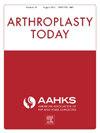Revision Rates for Aseptic Loosening in the Obese Patient: A Comparison Between Stemmed, Uncemented, and Unstemmed Tibial Total Knee Arthroplasty Components
IF 2.1
Q3 ORTHOPEDICS
引用次数: 0
Abstract
Background
Total knee arthroplasty (TKA) is an effective treatment option for high body mass index (BMI) patients achieving similar outcomes to nonobese patients. However, increased rates of aseptic loosening in patients with a high BMI have been reported. Component fixation is a concern when performing TKA in the obese patient. To address this concern in cemented TKA, extended tibial stems have been used. Uncemented implants that take advantage of biologic osseointegration have also been advocated. This retrospective study examined the use of and revision rates of extended cemented tibial stems and uncemented implants compared with conventional cemented implants in our high BMI patient population.
Methods
We retrospectively reviewed a prospectively maintained database of 3239 primary Attune TKAs (Depuy, Warsaw, Indiana). All obese patients (BMI > 30 kg/m2) with > 30 months of follow-up were included in our analysis. Those who underwent cemented TKA using a tibial stem extension (Group 1) (n = 145) and those where cementless implants were used (Group 2) (n = 100) were compared to a control group (n = 1243) using a standard cemented implant. Primary outcome measures were all-cause revision, revision for aseptic loosening, and revision for tibial loosening. Kaplan-Meier survival analysis and Cox regression models were used to compare the primary outcomes between groups.
Results
In total, there were 1512 knees that met the inclusion criteria. The mean follow-up was 6.8, 5.1, and 5.3 years for cemented, stemmed, and cementless groups, respectively. There were 37 all-cause revisions identified. Seven were for aseptic loosening (2 tibial, 1 femoral, and 4 involving both components); all of these were in the standard cemented implant group. There were no revisions in the stemmed or cementless implant groups. Survival analysis did not show any significant differences between groups for either all-cause revision or for aseptic loosening.
Conclusions
This retrospective analysis showed that there were no revisions required for aseptic loosening when a cemented, stemmed, or uncemented implant was used in obese patients. These findings show that cementless and extended stem implants are a reasonable option in obese patients.
Level of evidence
Level III.
肥胖患者无菌性松动的翻修率:有柄、无骨水泥和无柄胫骨全膝关节置换术部件的比较
背景:全膝关节置换术(TKA)是高体重指数(BMI)患者的有效治疗选择,其结果与非肥胖患者相似。然而,据报道,高BMI患者无菌性松动的发生率增加。在对肥胖患者进行全膝关节置换术时,部件固定是一个值得关注的问题。在骨水泥TKA中,为了解决这个问题,延长胫骨干被使用。利用生物骨整合的非胶结种植体也被提倡。本回顾性研究调查了在我们的高BMI患者群体中,与常规骨水泥种植体相比,延长骨水泥胫骨干和非骨水泥种植体的使用和翻修率。方法回顾性分析了3239例原发Attune tka (Depuy, Warsaw, Indiana)的前瞻性数据库。所有肥胖患者(BMI >;30 kg/m2), >;我们的分析包括30个月的随访。与使用标准骨水泥种植体的对照组(n = 1243)相比,使用胫骨干延伸进行骨水泥TKA的患者(1组)(n = 145)和使用无骨水泥种植体的患者(2组)(n = 100)。主要观察指标为全因翻修、无菌性松动翻修和胫骨松动翻修。采用Kaplan-Meier生存分析和Cox回归模型比较各组间主要结局。结果共有1512例膝关节符合纳入标准。骨水泥组、根茎组和无骨水泥组的平均随访时间分别为6.8年、5.1年和5.3年。共发现37个全因修正。7例为无菌性松动(2例胫骨,1例股骨,4例涉及两个部位);均为标准骨水泥种植体组。无骨水泥或有柄种植体组无修复。生存分析未显示两组间全因翻修或无菌性松动有任何显著差异。结论:本回顾性分析显示,在肥胖患者中使用骨水泥、茎干或非骨水泥种植体时,不需要对无菌松动进行修正。这些发现表明,无骨水泥和延长茎植入物是肥胖患者的合理选择。证据等级:III级。
本文章由计算机程序翻译,如有差异,请以英文原文为准。
求助全文
约1分钟内获得全文
求助全文
来源期刊

Arthroplasty Today
Medicine-Surgery
CiteScore
2.90
自引率
0.00%
发文量
258
审稿时长
40 weeks
期刊介绍:
Arthroplasty Today is a companion journal to the Journal of Arthroplasty. The journal Arthroplasty Today brings together the clinical and scientific foundations for joint replacement of the hip and knee in an open-access, online format. Arthroplasty Today solicits manuscripts of the highest quality from all areas of scientific endeavor that relate to joint replacement or the treatment of its complications, including those dealing with patient outcomes, economic and policy issues, prosthetic design, biomechanics, biomaterials, and biologic response to arthroplasty. The journal focuses on case reports. It is the purpose of Arthroplasty Today to present material to practicing orthopaedic surgeons that will keep them abreast of developments in the field, prove useful in the care of patients, and aid in understanding the scientific foundation of this subspecialty area of joint replacement. The international members of the Editorial Board provide a worldwide perspective for the journal''s area of interest. Their participation ensures that each issue of Arthroplasty Today provides the reader with timely, peer-reviewed articles of the highest quality.
 求助内容:
求助内容: 应助结果提醒方式:
应助结果提醒方式:


